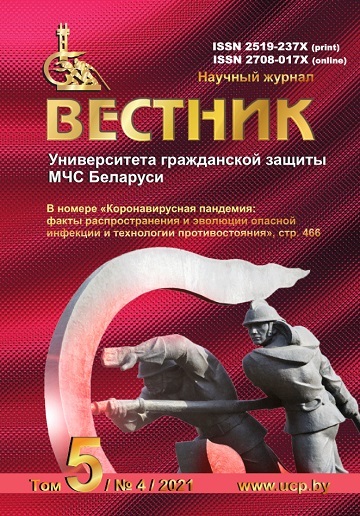Лабораторные исследования уровенного режима каскада гидроузлов Азербайджанской Республики
DOI:
https://doi.org/10.33408/2519-237X.2021.5-4.447Ключевые слова:
водохранилище, каскад гидроузлов, критерии подобия, моделирование, оценка риска, чрезвычайные ситуацииАннотация
Цель. Определить скорость изменения уровня воды в каждой ступени каскада на реке Куре с учетом величины боковой приточности и в зависимости от сценария возникновения аварийной ситуации при максимальных водосбросных расходах.
Методы. Лабораторные исследования уровенного режима искусственных водных объектов и методы моделирования установившегося неравномерного плавно изменяющегося движения жидкости.
Результаты. Разработана методика проведения лабораторных исследований уровенного режима каскада гидроузлов, позволяющая устанавливать зависимость уровня поднятия воды Н (м) в нижележащем водоеме от расхода Q (м3/с) и времени ее поступления T (с) при различных сценариях возникновения аварии на вышележащем гидроузле, а также определять значения скорости поднятия уровня воды в верхних бьефах водоемов.
Область применения исследований. Результаты исследований являются составной частью методики по оценке риска возникновения чрезвычайных ситуаций на искусственных водных объектах, расположенных в каскадах, позволяющей оценивать вероятностную меру опасности возникновения чрезвычайных ситуаций, разработку кратко- и среднесрочных прогнозов возникновения аварийных ситуаций.
Библиографические ссылки
Chugaev R.R. Gidravlika (tekhnicheskaya mekhanika zhidkosti) [Hydraulics (technical fluid mechanics)]: 4th edition. Leningrad: Energoizdat, 1982. 672 p. (rus)
Frenkel' N.Z. Gidravlika [Hydraulics]. Moscow: Gosenergoizdat, 1956. 456 p. (rus)
Pastukhov S.M. Otsenka riska vozniknoveniya chrezvychaynykh situatsiy na gidrouzlakh Respubliki Belarus', raspolozhennykh v kaskadakh [Assessment of the risk of emergencies at hydrolic units of the Republic of Belarus located in cascades]. PhD tech. sci. diss.: 05.26.02. Minsk, 2011. 132 p. (rus)
Ismayylov G.Kh., Perminov A.V. Modelirovanie rezhima raboty kaskada gidrouzlov Verkhnevolzhskoy vodokhozyaystvennoy sistemy [Modeling of the operating mode of the hydraulic units cascade of the Upper Volga management system]. Prirodoobustroystvo, 2020. No. 2. Pp. 99–103. (rus). DOI: https://www.doi.org/10.26897/1997-6011-2020-2-99-104.
Schislenok V.N. et al. Sovershenstvovanie upravleniya kaskadom volzhskikh vodokhranilishch na osnove gidrodinamicheskikh modeley i GIS-tekhnologiy [Improving the management of the cascade of the Volga reservoirs based on hydrodynamic models and GIS technologies]. Melioratsiya i vodnoe khozyaystvo, 2002. No 2. Pp. 8–12. (rus)
Bednaruk, S.E. O planirovanii meropriyatiy po snizheniyu riska ushcherbov ot navodneniy [On planning measures to reduce the risk of flood damages] / S.E. Bednaruk // Bezopasnost' energeticheskikh sooruzheniy: scientific, technical and production collection, 2003. Iss. 11. Pp. 407–414. (rus)
Bednaruk S.E., Motovilov Yu.G. Opyt upravleniya kaskadom volzhskokamskikh vodokhranilishch s ispol'zovaniem imitatsionnykh matematicheskikh modeley v period vesennego polovod'ya [The experience of managing a cascade of Volzhskokamsk water storage reservoirs using simulation mathematical models during the spring flood]: electronic resource. Proc. Intern. conf. «Upravleniye vodno-resursnymi sistemami v ekstremal'nykh usloviyakh», Moscow, June 4–5, 2008. 1 electronic optical disc (CD-ROM). (rus)
Malik L.K. Faktory riska povrezhdeniya gidrotekhnicheskikh sooruzheniy. Problemy bezopasnosti [Risk factors of hydraulic structures damage. Safety concerns]. Moscow: Nauka, 2005. 354 p. (rus)
Levkevich V.E., Pastukhov S.M. Analiz eksperimental'nykh dannykh po modelirovaniyu urovennogo rezhima kaskadov vodokhranilishch pri vozniknovenii avariynykh situatsiy [Analysis of experimental data on modeling the level regime of reservoir cascades in the event of emergency situations]. Vestnik Komandno-inzhenernogo instituta MChS Respubliki Belarus', 2010. No. 2 (12). Pp. 14–25. (rus)
Pastukhov S.M. Metodika laboratornykh issledovaniy urovennogo rezhima vodokhranilishch, raspolozhennykh v kaskadakh [Technique for laboratory studies of the level regime of reservoirs located in cascades]. Vestnik Komandno-inzhenernogo instituta MChS Respubliki Belarus', 2010. No. 2 (12). Pp. 4–13. (rus)
Bogoslavchik P.M. Rezervnye vodosbrosy s razmyvaemymi gruntovymi vstavkami na malykh vodokhranilishchakh i prudakh gidromeliorativnykh sistem [Reserve spillways with soil inserts that can be eroded at small water reservoirs and ponds of irrigation and drainage systems]. PhD tech. sci. diss.: 06.01.02. Minsk, 1986. 158 p.
Опубликован
Как цитировать
Лицензия
Все права защищены (c) 2021 Пастухов С.М., Османов Х.С., Бузук А.В.

Это произведение доступно по лицензии Creative Commons «Attribution-NonCommercial» («Атрибуция — Некоммерческое использование») 4.0 Всемирная.




















